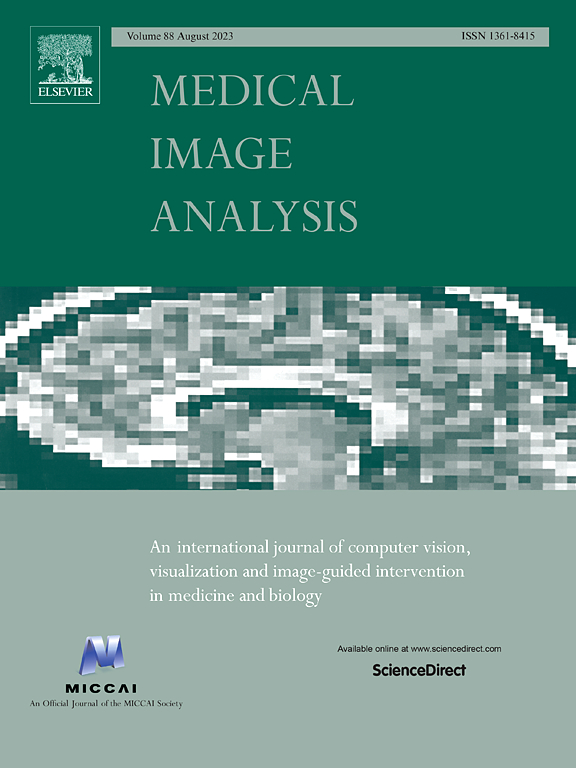HistoKernel: Whole slide image level Maximum Mean Discrepancy kernels for pan-cancer predictive modelling
IF 10.7
1区 医学
Q1 COMPUTER SCIENCE, ARTIFICIAL INTELLIGENCE
引用次数: 0
Abstract
In computational pathology, labels are typically available only at the whole slide image (WSI) or patient level, necessitating weakly supervised learning methods that aggregate patch-level features or predictions to produce WSI-level scores for clinically significant tasks such as cancer subtype classification or survival analysis. However, existing approaches lack a theoretically grounded framework to capture the holistic distributional differences between the patch sets within WSIs, limiting their ability to accurately and comprehensively model the underlying pathology. To address this limitation, we introduce HistoKernel, a novel WSI-level Maximum Mean Discrepancy (MMD) kernel designed to quantify distributional similarity between WSIs using their local feature representation. HistoKernel enables a wide range of applications, including classification, regression, retrieval, clustering, survival analysis, multimodal data integration, and visualization of large WSI datasets. Additionally, HistoKernel offers a novel perturbation-based method for patch-level explainability. Our analysis over large pan-cancer datasets shows that HistoKernel achieves performance that typically matches or exceeds existing state-of-the-art methods across diverse tasks, including WSI retrieval (n = 9324), drug sensitivity regression (n = 551), point mutation classification (n = 3419), and survival analysis (n = 2291). By pioneering the use of kernel-based methods for a diverse range of WSI-level predictive tasks, HistoKernel opens new avenues for computational pathology research especially in terms of rapid prototyping on large and complex computational pathology datasets. Code and interactive visualization are available at: https://histokernel.dcs.warwick.ac.uk/.

HistoKernel:用于泛癌症预测建模的全幻灯片图像级最大平均差异核
在计算病理学中,标签通常只能在整个幻灯片图像(WSI)或患者水平上使用,因此需要弱监督学习方法,通过汇总斑块水平的特征或预测来产生WSI水平的评分,用于临床重要任务,如癌症亚型分类或生存分析。然而,现有的方法缺乏一个理论基础的框架来捕捉wsi内斑块集之间的整体分布差异,限制了它们准确和全面地模拟潜在病理的能力。为了解决这一限制,我们引入了HistoKernel,这是一种新的wsi级最大平均差异(MMD)内核,旨在使用局部特征表示量化wsi之间的分布相似性。HistoKernel实现了广泛的应用,包括分类、回归、检索、聚类、生存分析、多模态数据集成和大型WSI数据集的可视化。此外,HistoKernel提供了一种新的基于微扰的补丁级可解释性方法。我们对大型泛癌症数据集的分析表明,HistoKernel在不同任务上的表现通常与现有最先进的方法相当或超过,包括WSI检索(n = 9324)、药物敏感性回归(n = 551)、点突变分类(n = 3419)和生存分析(n = 2291)。通过开创性地使用基于核的方法来完成各种wsi级别的预测任务,HistoKernel为计算病理学研究开辟了新的途径,特别是在大型复杂计算病理学数据集的快速原型方面。代码和交互式可视化可在:https://histokernel.dcs.warwick.ac.uk/。
本文章由计算机程序翻译,如有差异,请以英文原文为准。
求助全文
约1分钟内获得全文
求助全文
来源期刊

Medical image analysis
工程技术-工程:生物医学
CiteScore
22.10
自引率
6.40%
发文量
309
审稿时长
6.6 months
期刊介绍:
Medical Image Analysis serves as a platform for sharing new research findings in the realm of medical and biological image analysis, with a focus on applications of computer vision, virtual reality, and robotics to biomedical imaging challenges. The journal prioritizes the publication of high-quality, original papers contributing to the fundamental science of processing, analyzing, and utilizing medical and biological images. It welcomes approaches utilizing biomedical image datasets across all spatial scales, from molecular/cellular imaging to tissue/organ imaging.
 求助内容:
求助内容: 应助结果提醒方式:
应助结果提醒方式:


